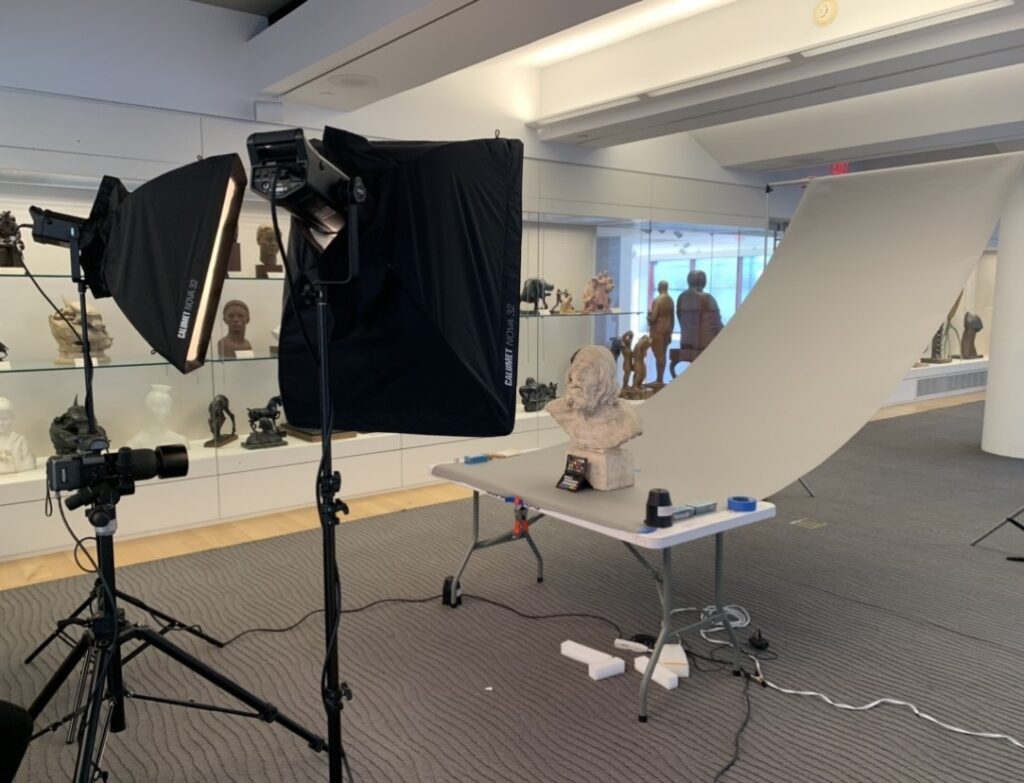Contributed by IMLS Grant Project Team
Summer in Philadelphia may be winding down, but things at PAFA are just starting to ramp up as we begin the early fall season. There is a lot to catch up on from just the last several weeks: the moving of the outdoor sculpture Grumman Greenhouse by Jordan Griska after 11 years on Lenfest Plaza, installation and prep of our upcoming shows Evade or Ensnare and Making American Artists, as well as fall classes at the school starting back up this month. And things with the IMLS Project Team is just as busy. We’ve continued working all summer on the most challenging phase of the IMLS grant project, photographing the permanent art collection.
We’ve changed course from photographing 2D works to taking photographs of the 3D works specifically in the Museum’s Sculpture Study Center (SSC). In this gallery, there is a wide array of objects in various mediums, each with their own set of challenges for documentation. Additionally, since the SSC is open to the public during Museum hours, we only have a limited number of days per week when things are closed to setup a temporary photography environment, work through as many objects as possible, and then break down again to make way for visitors.

We soon realized photographing sculptures presented other challenges in our workflow. First, art handling works on paper compared to 3D sculpture was dramatically different. Some works were fragile, while others were solid and sturdy. Art handling for sculptures made from bronze, stone, plaster, terracotta, or wood all proved challenging and required us to be really careful as some works were hundreds of years old or some were very heavy. The material/color of each sculpture also required different backdrops and lighting. We ended up planning our days around dark and light colored sculptures so we didn’t need to change the backdrop often. And finally, since a single 2D image cannot fully represent all viewing angles of a 3D space, each sculpture is being photographed at least ten times: four side views, four quarter angle views, and two 1/8th angle views. The effect of this will be a very useful (approximate) 360-degree global view of each artwork.
This workflow requires staff to move a—potentially very heavy—object, refocusing the camera by hand, adjusting the lighting, and finally, taking the image. Overall, it has been a slow but rewarding process, and we feel the finished images will provide a much more comprehensive set of digital assets—for future researchers and the general public—to view online.
In fact, the usefulness of a more comprehensive set of viewing angles has been immediately clear as we have spent time with each object. A good example might be any of the several Abraham Lincoln life masks currently on view in SSC. Aside from being interesting objects by themselves, they—like many of the objects in PAFA’s collections—have a variety of notes, marking, and surprising armatures on their reverse sides, that might not always be visible to the public, but all contribute to the unique character and story of each work.

We will soon be turning our attention to back to Works on Paper (WOP) and different aspects of the IMLS grant but we have enjoyed our time with the objects in SSC this summer and hope you will too the next time you are visiting the musem or browsing the new and forthcoming online collection.
This blog post is part of an ongoing series about Digital Collections that we are able to undertake thanks to a grant from the Institute of Museum and Library Services (IMLS).
About the Institute of Museum and Library Services
The Institute of Museum and Library Services is the primary source of federal support for the nation’s libraries and museums. We advance, support, and empower America’s museums, libraries, and related organizations through grantmaking, research, and policy development. Our vision is a nation where museums and libraries work together to transform the lives of individuals and communities. To learn more, visit https://www.imls.gov/and follow us on Facebook and Twitter.